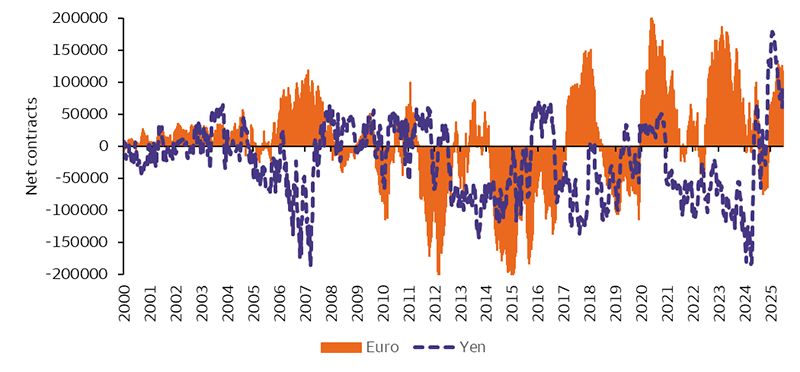October 28, 2025
Tony Miano, CFA, CAIA, Investment Strategy Analyst
Dollar weakens, pessimism grows
 Sources: Bloomberg and Wells Fargo Investment Institute as of September 23, 2025. Speculator net contracts represented by non-commercial contracts in U.S. futures contracts as reported by the Commitments of Traders report (CFTC). A positive number represents a net long position in the currency and a negative number a net short position. Excerpted from Investment Strategy report (October 27, 2025)
Sources: Bloomberg and Wells Fargo Investment Institute as of September 23, 2025. Speculator net contracts represented by non-commercial contracts in U.S. futures contracts as reported by the Commitments of Traders report (CFTC). A positive number represents a net long position in the currency and a negative number a net short position. Excerpted from Investment Strategy report (October 27, 2025)Speculators’ positions in futures contracts expect the euro and yen to strengthen relative to the dollar
Despite increased investment in U.S. dollar-denominated assets from abroad, many foreign exchange speculators have bet against the dollar throughout 2025. The chart shows speculator net positions in euro and yen futures contracts; both have been positive for much of 2025, which means traders expect these currencies to strengthen relative to the dollar.
The widespread pessimism about the dollar may be magnified if investor concerns about continued Federal Reserve (Fed) rate cuts or a U.S. economic soft patch build into late 2025 and early 2026. As of late October, we see the potential for a slight retread lower in the dollar moving into year-end 2025.
What it may mean for investors
As we look into 2026, we believe this negative near-term view in the dollar should dissipate. In our view, it would not take much of a sentiment shift to lead many investors to reverse their bets against the dollar — potentially boosting its value. This shift in sentiment could be caused by a host of factors, including an early stall in the Fed’s rate cutting cycle, stronger U.S. growth, or rising political risks internationally. We expect a slight rebound in the dollar by year-end 2026.
Risk Considerations
Each asset class has its own risk and return characteristics. The level of risk associated with a particular investment or asset class generally correlates with the level of return the investment or asset class might achieve. Stock markets, especially foreign markets, are volatile. Stock values may fluctuate in response to general economic and market conditions, the prospects of individual companies, and industry sectors. Foreign investing has additional risks including those associated with currency fluctuation, political and economic instability, and different accounting standards.
Investments in currencies involve certain risks, including credit risk, interest rate fluctuations, fluctuations in currency exchange rates, derivative investment risk and the effect of political and economic conditions. The use of currency transactions to seek to achieve gains in the portfolio could result in significant losses to the portfolio which exceeds the amount invested in the currency instruments. In addition, exchange rate movement between the U.S. dollar and foreign currencies may cause the value of the fund’s investments to decline.
General Disclosures
Global Investment Strategy (GIS) is a division of Wells Fargo Investment Institute, Inc. (WFII). WFII is a registered investment adviser and wholly owned subsidiary of Wells Fargo Bank, N.A., a bank affiliate of Wells Fargo & Company.
The information in this report was prepared by Global Investment Strategy. Opinions represent GIS’ opinion as of the date of this report and are for general information purposes only and are not intended to predict or guarantee the future performance of any individual security, market sector or the markets generally. GIS does not undertake to advise you of any change in its opinions or the information contained in this report. Wells Fargo & Company affiliates may issue reports or have opinions that are inconsistent with, and reach different conclusions from, this report.
The information contained herein constitutes general information and is not directed to, designed for, or individually tailored to, any particular investor or potential investor. This report is not intended to be a client-specific suitability or best interest analysis or recommendation, an offer to participate in any investment, or a recommendation to buy, hold or sell securities. Do not use this report as the sole basis for investment decisions. Do not select an asset class or investment product based on performance alone. Consider all relevant information, including your existing portfolio, investment objectives, risk tolerance, liquidity needs and investment time horizon. The material contained herein has been prepared from sources and data we believe to be reliable but we make no guarantee to its accuracy or completeness.
Wells Fargo Advisors is registered with the U.S. Securities and Exchange Commission and the Financial Industry Regulatory Authority, but is not licensed or registered with any financial services regulatory authority outside of the U.S. Non-U.S. residents who maintain U.S.-based financial services account(s) with Wells Fargo Advisors may not be afforded certain protections conferred by legislation and regulations in their country of residence in respect of any investments, investment transactions or communications made with Wells Fargo Advisors.
Wells Fargo Advisors is a trade name used by Wells Fargo Clearing Services, LLC and Wells Fargo Advisors Financial Network, LLC, Members SIPC, separate registered broker-dealers and non-bank affiliates of Wells Fargo & Company.


